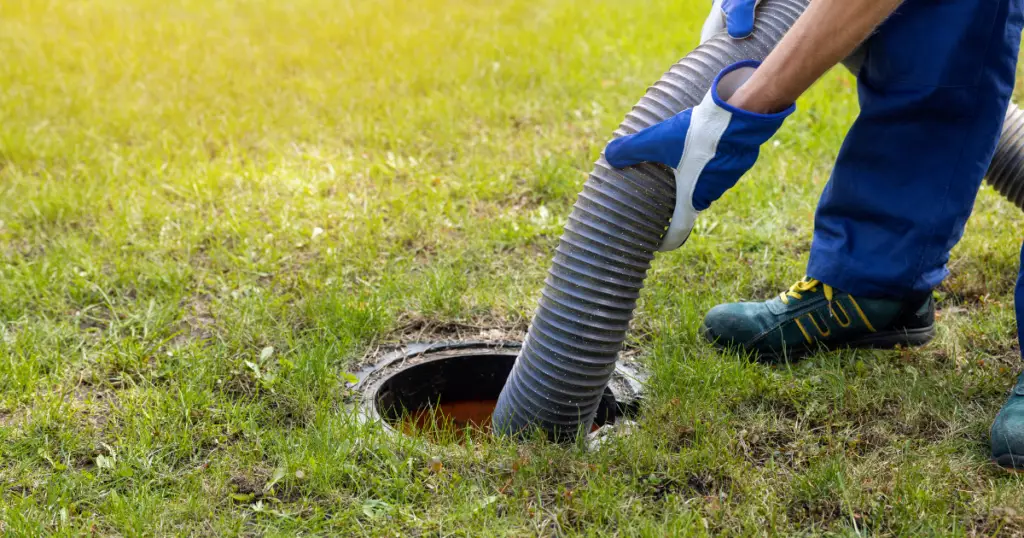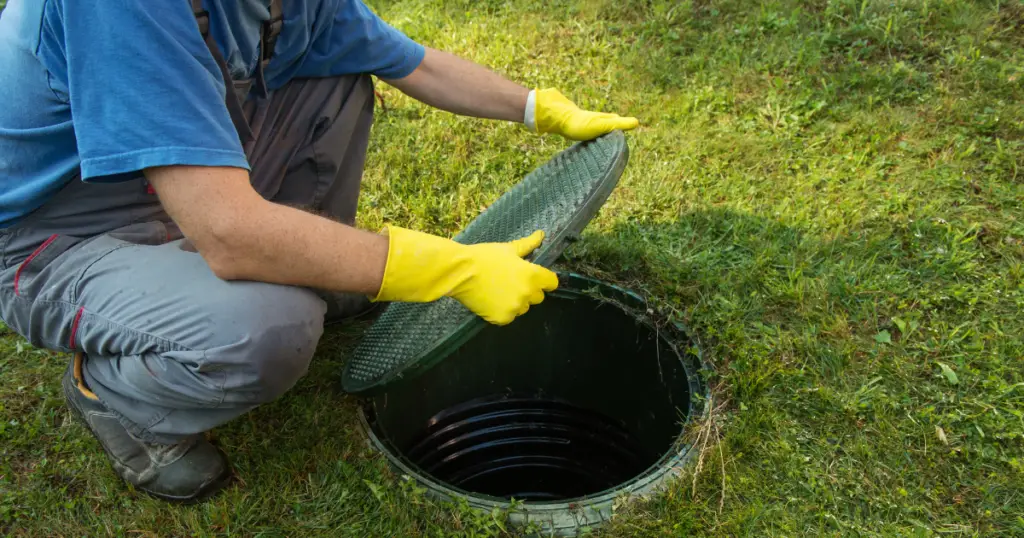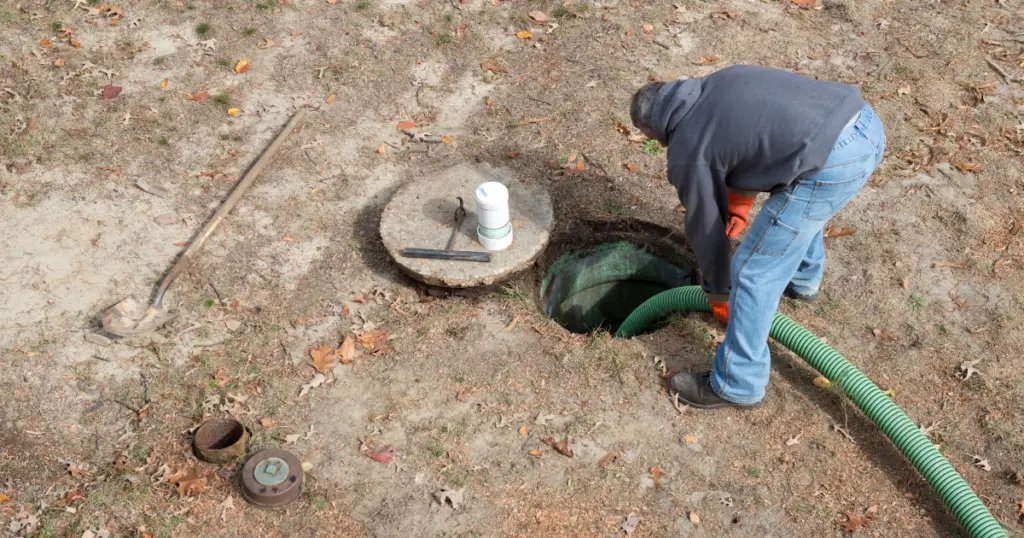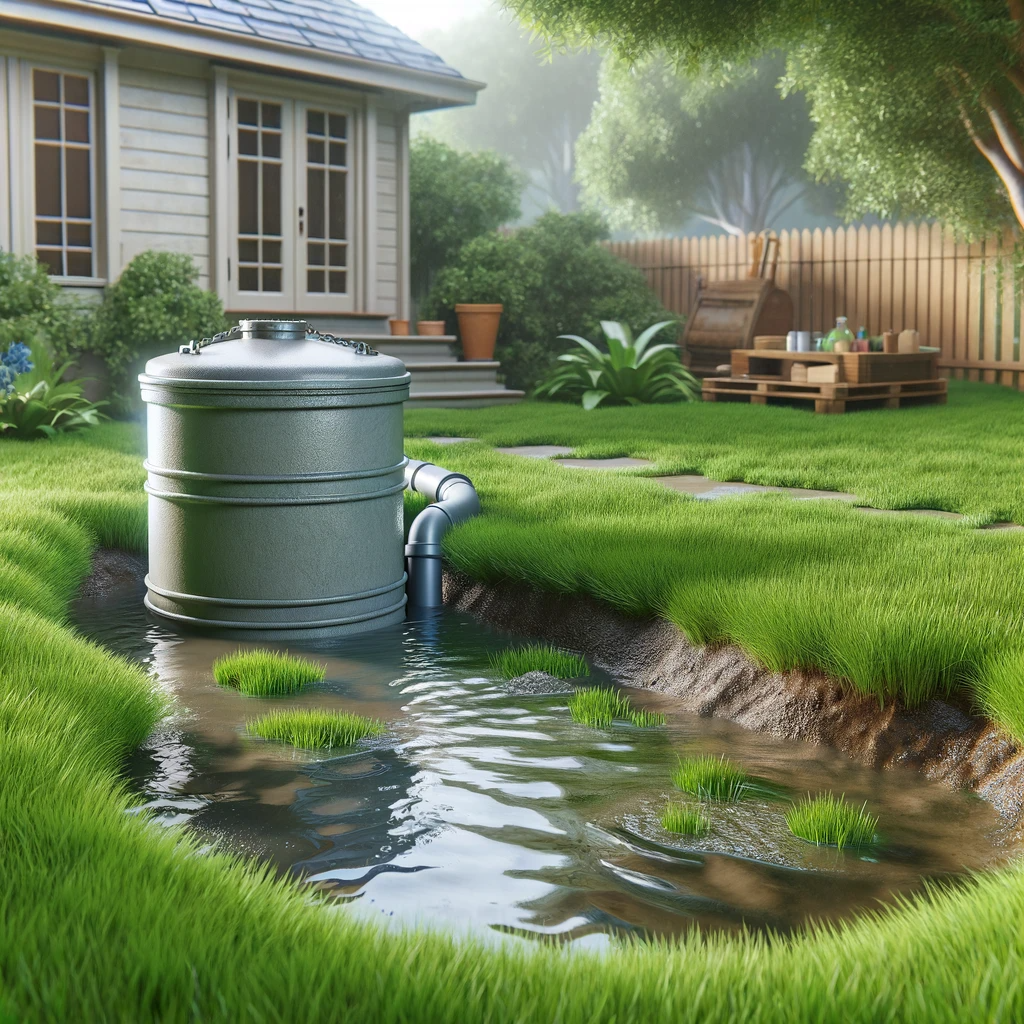Understanding the indications of flooded septic systems is critical to prevent damage and expensive repairs. Additionally, comprehending how this system functions – along with all related knowledge – can help you to properly maintain your system and steer clear of any future issues.
What is a septic tank?
A septic tank is an essential component of a conventional septic system. Septic systems are used primarily in rural and semi-rural areas where sewer lines do not exist. It collects the raw sewage and waste water from the bathroom, kitchen, and other areas of a house and stores it in an isolated location away from the home. The septic tank is usually buried underground and contains two chambers – one for solids, and one for liquids.

How do septic tanks works?
Septic tanks work by separating and storing wastewater from a home or business. The tank is usually made from concrete, fiberglass, or plastic, and is buried underground. Inside the tank, bacteria break down the waste into three layers: scum (which floats to the top), sludge (which settles at the septic tank bottom), and effluent (grey water in between).
As wastewater flows into the tank, solid waste settles to the bottom, while lighter materials such as oil, grease, and scum rise to the top. Bacteria break down the organic matter so that only liquid waste exits the tank.
From the tank, effluent flows out through a drain pipe and into a leach field—also known as a septic drain field—where it is slowly released into the soil to be further treated. The leach fields are typically composed of several pipes with holes at points along their length that allow even distribution of liquid.
In summary, septic tanks are responsible for containing and disposing of all of your home’s wastewater efficiently and safely.
Why is my drain field flooded?
If your drain field is flooded, it could be due to several factors. One common factor is ground water—if the water table rises close to or above the surface of the drain field, there will not be enough room for wastewater from your septic system to properly disperse into the soil.
Heavy rains can also cause flooding in your drain field, as the extra precipitation will cause overflow and saturation of the leaching system. Additionally, if there is a system failure in some part of your septic tank—such as a clog or broken pipe—the excess water may back up into the drain field and cause flooding.
In addition, the following causes may contribute to a flooded septic system:
- Poorly designed leach lines that lack proper slope or are too shallow;
- Clogged pipes;
- High groundwater levels;
- System failure;
- Problems with the septic tank, such as a full tank, blocked outlets, cracked pipes, root intrusion, or a faulty effluent filter;
- Poor maintenance and overuse of the tank lead to capacity issues;
- Water that has nowhere to go due to high water table levels.
If you suspect any of these issues are causing septic problems, have your tank inspected by an experienced professional for assistance.

What are the signs of a flooded septic system?
Knowing the signs can help you prevent long-term damage to your entire system. Here is a list of common signs that indicate your septic system is flooded:
- Loud gurgling sounds comming from your house’s plumbing fixtures when they are in use, such as flushing a toilet or doing laundry.
- Standing water in or around the area of your septic tank or septic field.
- Slow running toilet, sinks and drains.
- Bad smells coming from your drain pipes or from outside near the septic tank/septic field area.
- Foul odors in areas where the water table is close to ground levels, such as basements, bathrooms, and laundry rooms.
- Sewage backups into homes and buildings due to inadequate maintenance or clogged sewers prevent wastewater from traveling through pipes correctly to get it out of your system.
- Wet spots in areas where water typically does not accumulate, especially around the perimeters of your property and beyond, such as ditches and low-lying areas adjacent to deep canals or ponds that are close by.
- An unusual amount of vegetation growth (like grass) in wet spots that don’t normally contain any sort of vegetation if they have gone unnoticed for an extended period, could be a sign that your septic system has been compromised by flooding due to excessive overuse or general neglect over time – both conditions can cause flooding issues with a failed septic system.
- Clogged drains require frequent unclogging and more frequent pumping out of solids collected in the tank.
If you suspect damage or flooding to your septic system, contact a professional for assistance. A qualified technician will be able to inspect the system and provide a solution to address the issue.
What to do immediately after a flooded septic tank?
After a septic tank has been flooded, there is an immediate need to take action to prevent any further damage from occurring. Here are the steps you should take immediately:
- Relieve Pressure: If the flooding occurred due to a blocked outlet tee or perforated pipe, it is important to first relieve pressure on the septic tank by opening the outlet tee and allowing excess water to flow out.
- Stop All Water Use: After pressure has been relieved, all sources of water must be stopped to reduce any additional water from entering the tank and exacerbating the flood situation. This includes turning off appliances and discontinuing all uses of water until further assessment can be conducted.
- Assess Damage: After pressure has been relieved and all sources of water have been turned off, it’s time to assess any damage that may have occurred due to the flooding. This includes inspecting your system for visible signs of damage such as cracks or broken pipes, as well as checking if your pump or other components are still functioning properly.
- Clean Up: Once you have assessed any potential damage and determined what repairs are needed, it’s time to begin cleaning up the mess left behind by the flooding. This involves removing debris and dirt from around your septic system components so that work can begin on restoring them to their original condition.
- Contact a Professional: You must contact a professional plumber or septic service before attempting any repairs yourself as this could result in further damage being done if not done correctly. A professional will be able to identify the cause of the flooding and make sure that your system is restored safely and effectively, providing you with peace of mind for years to come.
In addition to the steps listed above, it is important to take caution when dealing with a flooded septic tank and sewer lines.
Make sure you are wearing protective clothing and using appropriate safety measures when handling any wastewater or septic materials, as these can often contain hazardous substances.

How often should I have my septic tank pumped?
Regularly scheduled septic tank pump-outs are an important part of keeping a septic system working efficiently and safely. It is generally recommended that septic tanks be pumped every three to five years, depending on the size and usage levels of the tank.
Regularly scheduled maintenance can help prevent costly emergency repair jobs down the road, so it’s best to stick to a routine pumping and repair schedule when it comes to your septic system.
Should I pump my tank during flooded or saturated conditions?
During flooded or saturated soil conditions, it is not recommended to pump out a septic tank. The additional pressure caused by the saturated soil can cause the tank’s walls and internal components to shift or collapse, resulting in costly repairs.
Additionally, the groundwater can carry contaminants from outside sources into the tank, potentially making it unsafe for reuse or risking contamination of surrounding soil and groundwater.
If your septic tank needs to be pumped during a flood or high water table, it’s best to contact a professional plumber who will be able to assess the situation and provide guidance on closing off wastewater lines and preventing contaminated water from entering your system.
Can heavy rain back up a septic system?
Heavy rain can cause a septic system to back up, particularly if the drainage field is saturated or clogged with debris. When heavy rain occurs, the amount of water flowing into the tank may exceed its capacity to handle it.
Under worst conditions, pumping it out could cause the tank to try to float out of the ground and may damage the inlet and outlet pipes. This excess water can then fill the tank faster than it can be released into the drain field resulting in a buildup of wastewater in the tank and potential backups. Preventive measures can be taken to help alleviate this problem such as improving soil drainage, installing overflow pipes, and regularly pumping out your tank.
How to prevent my septic tank from flooding?
To prevent your septic tank from flooding, there are a few preventive measures you can take.
- Install a Siphon Breaker: Installing a siphon breaker is one of the best ways to prevent your septic tank from flooding. The siphon siphonhon breaker is designed to stop wastewater from flowing back up into the tank and thereby preventing it from overflowing.
- Clear Clogs: Clogs can cause septic tanks to flood, so make sure that you regularly inspect and clear away any debris or blockages in the system. If necessary, hire a professional who is experienced with septic systems to do this for you.
- Avoid Using Too Much Water: You should avoid overloading your septic tank by reducing your water usage as much as possible – if you have a lot of people living in your home, restrict showers and laundry activities to specific times during the day instead of throughout the whole day.
- Inspect Regularly: Make sure that you check your septic system at least once every two years, and get it professionally inspected annually – this will help identify any potential problems before they become too serious and cause flooding.
- Install Roof Gutters: Installing roof gutters can help to protect your septic tank by preventing any excess rainwater from pooling around the tank and possibly spilling over. Also, make sure that all downspouts are directed away from your tank for extra protection.
- Wash Clothes Less Frequently: If you’re looking for ways to conserve water, try washing clothes less frequently. Not only will this reduce your water bill but it also prevents your septic system from being overloaded with effluent.
- Conserve Water in Other Ways: There are other simple ways to conserve water, such as taking shorter showers or turning off the tap when brushing your teeth. Additionally, switch to low-flow systems like shower heads and taps to save even more water each day – this will help reduce the pressure on your septic system and prevent flooding issues caused by an overload of wastewater.
- Pump Your Tank: To reduce the risk of your septic tank overflowing, it’s important to have it pumped periodically (every three years on average). A professional will be able to accurately determine how often you need pumping, depending on how much wastewater is being generated in your household.
Call a professional help
When dealing with a septic tank, it is always best to call a professional for help. Expert technicians are trained to diagnose and repair septic tanks and can also provide advice on preventative measures such as regular maintenance visits. A professional will be able to assess the situation correctly and advise further action more accurately than an amateur.
Furthermore, they have access to the right tools and materials required for any necessary repairs or replacements, ensuring that everything is done correctly the first time around. While prevention is better than cure, if you find yourself facing a flooded septic tank then do not hesitate to call a professional – they will be able to fix your problem quickly and efficiently.



